Scroll down the page or click on the
place names to view information
Langstone Rock and the
Seawall.
The main interest in this
area is seabirds, both wintering and on passage. The seawall provides a good
area to view out to sea and Langstone Rock provides a great vantage point
across the mouth of the estuary and Dawlish Bay, although climbing it can be dangerous
especially after rain. Both sites can be exposed in bad weather and the rock is not
recommended in strong winds.
In winter these areas are
often the best to view any divers, grebes or scoters present.
During good seawatching conditions shearwaters, terns and skuas are
often seen. Scarcities have included Bonaparte's Gull, Surf Scoter, Little Auk, Sabine’s Gull, Leach’s Petrel and White fronted Goose.
At low tide the rocks at the
base of Langstone Rock and the sea wall used to be a regular haunt of Purple Sandpiper,
but these are now rare. Turnstone and Oystercatchers still remain as well as
Brent Geese and
good numbers of gulls.
The landward side of the
seawall is often disturbed but Pied Wagtail and Rock Pipit do feed here. In autumn
and winter there is always the chance of a Black Redstart.
Plants of interest in this
area include the only Black Spleenwort and Rock Sea-lavender on Langstone Rock. The grassy area behind the
sea wall has been much developed but some areas hold Mossy Stonecrop, Early
Meadow-grass and Small-flowered Buttercup.
The Car Park was only
officially created in the late 1970’s and replaced an area of outstanding dune
grassland. The Sand Crocus behind the Visitor Centre was transplanted to there
from the car park during construction.
The area does not hold much in the way of birds, except for providing some of the only breeding sites for Starling and House Sparrow. Commoner species such as Dunnock and Whitethroat breed in the Bramble and Gorse and a pair of Cirl Bunting is often present. Few scarce birds have been recorded on this busy area, although a Rose-coloured Starling and three Woodlark were notable.
Before the new drainage was installed, the Car Park would flood and after storms species such as Little Gull and Kittiwake had been recorded. One of these pools was even visited briefly by a Little Ringed Plover. Since the drainage ditches were established scrub has developed and this has held species such as Wryneck and Yellow-browed Warbler.
Botanically this is one of the richest areas away from the Golf Course, it is however not part of the SSSI. The heavy recreational use of this area does protect the site but the rarer clovers and other plants are getting hard to find. The disturbed nature of the area does however produce the occasional surprise, such as Mossy Stonecrop and Water Figwort, with several garden plants also being recorded. The entrance roundabout holds two nationally scarce liverworts and a good colony of Yellow-legged Mining Bee. The stands of Alexanders and later in the year, Hemlock Water Dropwort can be productive for pollinators and the Buffer Zone also holds good populations of Sandpit Mining Bee and Beewolf.
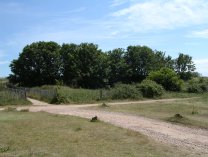
A small copse
of White Poplar and Sycamore always has the potential to hold something
interesting. The area can hold a good number of migrant warblers, feeding on the abundant aphids
but scarcer species are unusual. Several Firecrest have been
recorded but as yet the rarest sighting is of the Recording Area's second Monarch
butterfly.
The only example of Shrub Purslane on site grows under the Sycamore with Cockspur also recorded. The lichen flora of this area includes Ramalina fraxinia, a scarce species for which the UK has international responsibility.
The name is derived from a previous warden who once claimed this was where the Cuckoos nested every year!
Entrance Bushes and the
First Pond
|
This is the area
between the Buffer Zone and the Visitor Centre. The wide range of
habitats mean there is always something of interest throughout the year. The area around the First Pond especially,
can hold good numbers of warblers in
both spring and autumn, this is also one of the better spots to find Pied
Flycatcher on site. Chiffchaff and occasionally Firecrest over winter. Both Radde’s
and Dusky Warbler have been recorded, each the first to be twitchable in
Devon. Several Yellow-browed Warblers have also been recorded but as yet no
Pallas’s. |
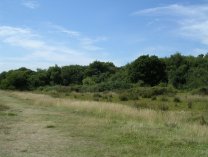 |
This also provides a
good area to see woodland species that are scarce on site, Great-spotted
Woodpecker now breeds, whilst Coal Tit and Treecreeper can be found at the right
time of year and both Marsh and Willow Tit have been recorded. The pond holds breeding Reed Warbler and in autumn
and winter, Water Rail, and Grey Wagtail may be seen.
The area near the Visitor Centre has a wide range of rare plants, the star being Petalwort, an internationally scarce liverwort. The transplanted Sand Crocus has spread and can be seen in several areas alongside Upright Chickweed, Shepard's Cress and Subterranean Clover. The damper areas hold species such as Water Mint, Purple Loosestrife and Southern Marsh Orchid with Marsh Helleborine now in abundance. The site's only Butcher's-broom and Scots Pine are found amongst the willow scrub.
Slender and Common
Groundhopper have been recorded in this area and Long-winged Conehead
has colonised. Stands of Hemp Agrimony attract pollinators including the
nationally rare Black Mining Bee and the scarce soldierfly Ornate Brigadier
whilst the Hornet Hoverfly can also be found.
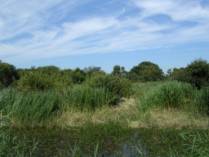
This is the largest area of freshwater in the Recording Area and as such holds a range of species found nowhere else on site. In the summer there are several pairs of Reed Warbler and a pair of Reed Bunting as well as Moorhen and Little Grebe, but Coot are now absent.
Kingfisher, Water Rail, Grey
Heron and Cormorant are regular but few waders visit although Jack Snipe and
more unusually Avocet have been recorded. Rarities have included Bittern, Bearded Tit,
Black-necked Grebe and Great Reed
Warbler.
Wildfowl on the pond is
usually confined to Canada Goose and Mallard, but Shoveler and Teal are regular
in winter whilst Tufted Duck and Gadall have become scarce and there are several
spring records for Garganey.
The scrub around the pond,
like that around the First Pond, can hold good numbers of warblers but has yet
to hold anything rarer than Yellow-browed Warbler or Firecrest. Occasionally Tawny and even Long–eared Owl have
roosted here.
A range of aquatic plants present includes Mare’s Tail and Spiked Water-milfoil, both rare in Devon. Southern Marsh Orchid, Brookweed and Ragged Robin can also be found in several areas. Fritillary still survives but hasn't flowered recently.
The pond is a good site for
Odonata; the rarest of these is Hairy Dragonfly, which is usually seen in small
numbers each year with a recently established population of Small Red-eyed
Damselfly. Commoner species include Emperor and Migrant
Hawker although Broad-bodied Chaser has
become rare. The reedbeds also support a number of moth species with a good range of
Wainscots, in particular, being present. Some of these, along with
Cream-bordered Green Pea, which breed in the sallows, occur at few other sites
in Devon. Large numbers of Common Toads breed with Smooth Newt also present.
Since the first record in 2017 Water Vole has become established and Otter has
been recorded.
|
This area of
grassland is a good area to view the scrub edge; this is a good
place to find Spotted Flycatcher and Redstart during migration. Yellow Bartsia, Cuckooflower and Yellow Rattle can all be found here. Its sheltered nature is ideal for butterflies with Brown Argus and Common Blue being particularly numerous, but Orange-tip is much declined and the small population of Marbled White no longer survives. The Recording Area's only Roesel's Bush Cricket was here for several weeks in 2018. |
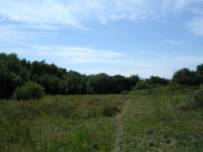 |
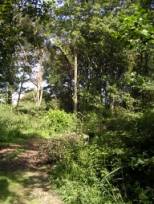
This is the largest area of Alder woodland away from
the Golf Course. The alders can hold migrants but viewing can be difficult.
Holding some of the tallest trees on site both Carrion Crow and Magpie breed, Sparrowhawk has in the past. Breeding numbers of other species are low, due to
the lack of natural holes, but Great and Blue Tits regularly use nest boxes.
Rarities recorded here include Barn Owl, Nightjar and amazingly Red-eyed Vireo,
which was first found here before moving nearer the Main Pond.
The ground flora is fairly
impoverished under the scrub; one area has been turned into a fire site and
cuttings dump, the combination of grass cuttings
and once even a dead dolphin (dug up off the beach) has heavily enriched the soil. The flush of nettles and
Hogweed does however provide food and nectar for Peacock and Red Admiral. Other species
present include Skullcap, Greater Pond-sedge, which is spreading in from
Greenland Lake along with Michaelmas Daisy.
The rides hold good numbers
of Speckled Wood with Ringlet also present, and are regularly patrolled by Migrant Hawker in autumn.
Lunar Hornet Clearwing has been recorded breeding in the sallows.
|
This area has a fascinating human and natural history. The area was originally a tidal creek separating the two sandspits. The name originated from the 19th century, when fishing and whaling vessels were laid up over winter for repair before heading back to fishing grounds off Greenland. The area was also used as a commercial shell fishery for several years. The entrance was blocked up and the creek was partially infilled in the 1940’s in an effort to stabilise the Warren. Once it ceased to become tidal, the area eventually began to dry out and the process of succession moved on rapidly. |
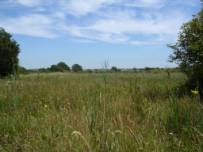 |
Being a large area of open
ground this is a favoured site for Wheatear, but a wide range of rarer migrants
has been recorded here including Hoopoe, Richard's Pipit, Woodlark and Great Spotted Cuckoo.
In winter, if flooded, the
area can hold Snipe and during storms even other waders such as Turnstone, Dunlin
and Lapwing, Whimbrel often use the area in spring. This is also one of the
best areas to see the scarcer (in Warren terms) thrushes; Ring Ouzel has been
recorded as well as flocks of Fieldfare and Redwing.
In summer the wetter areas
are covered with Southern Marsh Orchid, although numbers are much declined.
Other species present include a single Green-winged Orchid, Marsh Helleborine, Adder’s Tongue Fern as well as
the exotic Blue-eyed Grass. This area also holds the only examples of Guelder
Rose and Creeping Willow on site. Petalwort and Rabbit-moss both occur in this
area with a good covering of Cladonia lichens. Towards the eastern end of the lake the drier
grassland holds species such as Autumn Ladies Tresses, Hairy Dog-violet, Portland
Spurge and another translocated population of Sand Crocus.
Brown Argus can also be found in these drier areas, Common Blue, Large and Small Skippers are also present. The longer vegetation supports a good colony of Long-winged Coneheads and several Great Green Bush-crickets. Other species that have been recorded include Wasp Spider and Red-veined Darter, the latter, a teneral male, was found drying its wings and had presumably emerged from the Main Pond.
The current sea defence works are however designed to return this area (and the Main Pond, Back Meadow and Dead Dolphin Wood to a tidal creek, so the ecological riches of these areas are unfortunately time-limited.
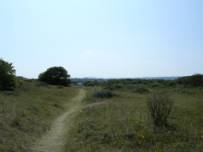
As the name suggests Wryneck has been recorded here,
the short turf providing ideal feeding areas for this rare
migrant but the removal of the surrounding cover has reduced the number of
migrants and breeding birds. This area between the path and the Dune Ridge is part of
Greenland Lake, but the habitat is markedly sandier. The area has recorded
Hoopoe and Long-eared Owl, both in the now removed lichen rich Sycamores, the remaining brambles hold most avian interest.
Whitethroat, Linnet and Stonechat all breed, but also occur in numbers on passage,
migrant Whinchat also favour this area. Other rarities have included Barred Warbler,
Woodchat Shrike and Rose-coloured Starling.
The grassland here also
holds a similar range of species as the dry areas in Greenland Lake, including
Autumn Ladies Tresses. More unusual species include Asparagus, Bee and Pyramidal Orchid. Lesser Centaury
and Petalwort grow in damper areas near the
path.
|
This small pond despite
its size has held breeding Moorhen and Mallard and regularly attracts flocks
of birds to drink and bathe; in autumn this is the best place on site to find
Sedge Warblers. The only population of
Glaucous Bulrush on site grew here, also Corky-fruited Water Dropwort, Marsh
Pennywort and Lesser Centaury can be found. Several species of dragonfly
breed, but the small population of Ruddy Darter was lost several years ago,
although migrants are still seen occasionally. |
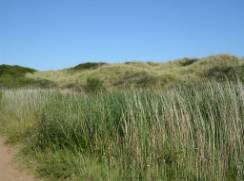 |
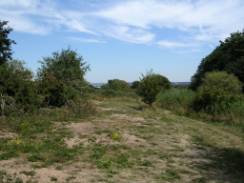
This path runs from the Main Pond alongside the Golf Course boundary
until it reaches the Dune Ridge. The habitat along the length of
this path is a mix of dune grassland and mixed scrub. This is a
good area for breeding species, Sylvia warblers in particular and
similarly is a good area for them on migration, especially nearer the Dune
Pond. Species occasionally recorded include Dartford Warbler and Lesser
Whitethroat; rarer species include Red-backed Shrike, Nightingale and
Subalpine and Barred Warbler.
The area has been damaged by regular vehicle access but are slowing recovering their botanical interest, although Yorkshire Fog is becoming dominant in some areas. The older areas hold a good range of spring ephemerals, including several species of Chickweed and clovers. Rarer species include Shepherd’s Cress, Upright Chickweed and previously Hairy Rockcress.
The areas of scrub above
the Back Meadow and Greenland Lake are a good place to find the Great Green
Bush-cricket. This, the largest cricket in the UK, is a Devon priority species and
is present in good numbers in the Recording Area.
|
“Along the Dune Ridge” can mean anywhere between the seawall and Warren Point. The whole length of the site was underpinned by a series of stone filled gabions; these were put in place in the 1970’s to protect the site from coastal erosion. Much of these were removed in recent sea defence work and the majority of the ridge has been lost. Access to the hide and Warren Point is now only possible along the beach. |
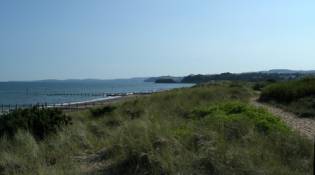 |
The whole length provides a good view both up the river and out to sea. Visible migration and seawatching are the two main activities on this part of the reserve; favoured seawatching areas include the end of the promenade, the end of the Back Path and by the 7th tee of the Golf Course known as John's Watch. Visible migration can be rewarding almost anywhere but is probably better from the west of the Dune Pond, where the noise of the waves are less pronounced. |
Few birds are actually recorded
on the Ridge, but Snow Bunting have been found feeding on the path on several
occasions. Rarities such as
Wood Warbler, Tree Sparrow and Long-eared Owl had been found in the few
Tamarisks that used to be present.
The main plant of this area is Marram, without it there would be no dunes, growing amongst it can be found Sea Bindweed as well as Hare’s Tail Grass but little else can survive. Convolvulus Hawkmoth caterpillars have been found occasionally feeding on the Sea Bindweed. Emperor dragonflies often patrol along the ridge along with robberflies and sand wasps, this is also one of the few areas on the reserve where Wall butterflies can be regularly seen.
Sand Lizard can still be found on the remaining sections with the population translocated before the area was reprofiled, unfortunately the same didn't happen for the populations of Bloxworth Snout previously found here.
The Beach and sandbars
Conveniently divided into sections by the installation of groynes in the 1970’s and again in 2018, this was one of the main high tide roosts until erosion accelerated. Dogs are now banned beyond Groyne 9 but access is now largely restricted at high tide by the tide itself. The remainder of the beach is often disturbed, but birds can be found feeding almost anywhere, especially during spring and autumn. In winter Sanderling and Turnstone are often present even at low tide, with Whimbrel numerous in Spring.
 |
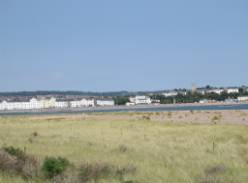 |
As the beach widens towards
Warren Point, the increase in vegetation and embryo dune previously attracted large
numbers of Linnet and other finches in autumn and winter. These birds are
feeding on the seed of plants such as Sea Rocket and Prickly Saltwort, which
can grow here in abundance. Other species, which
have been recorded along the tide line, include Thorn-apple, Sunflower, Hazel
and Beech.
Storm tides often change the shape of the beach but they can also bring large amounts of debris from further up the Exe. This debris accumulates on the beach and provides habitat for a range of species including a nationally rare woodlouse.
At low tide the sandbars
offshore are exposed, large numbers of gulls can gather here to feed. Other
species that can be present include Curlew, Oystercatcher and Brent Geese.
Red-breasted Merganser can be seen feeding in the channels sometimes with
scarcer species such as Long-tailed Duck and Velvet Scoter.
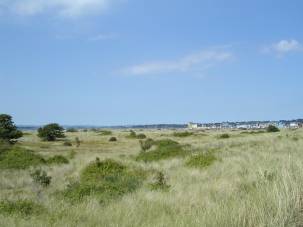
Another area of the site with an
interesting geological and human history. The Point has, at various times, been an island
separated at high tide from the remainder of the Warren, the installation
of gabions in the 1970’s and their removal and replacement with a Geotube in
2018 was designed to prevent this occurring again. During the middle of last century (c1920-1960) a series of holiday
homes and dwellings were built on the Point, but these were abandoned over time
to winter storms and the shifting sands. Their legacy however continues with
many of the reserve’s alien plants thought to have originated from the gardens
of these houses. Examples to be found on the Point include Yucca, Chinese Tea-plant and
Tree Lupin.
Birding the Point can be
unrewarding, a long walk often for little more than a few Skylark and
maybe a Chiffchaff, however it can hold migrants, even when the rest of the
site appears quiet. The open ground, with a few Sycamores and brambles, is
ideal for migrant Wheatear, Whinchat and Redstart. Warblers and Spotted
Flycatcher can also be present in the Sycamores. Occasionally
Warren Point does live up to its promise with Great Spotted Cuckoo, Savi’s
Warbler, Short-toed Lark, Great and Lesser Grey Shrike all being recorded.
Being the largest area of relatively undisturbed dune on the reserve, especially now dogs are banned, breeding Skylark have managed to maintain a presence in the Recording Area, although Meadow Pipit and Reed Bunting have joined Common Tern and Ringed Plover as lost breeding species.
The dune grassland is similar to the rest of the Recording Area, but the reduction in rabbit grazing has seen species such as Sand Sedge reduce the areas of short species rich turf, although there are large areas dominated by lichen and stonecrop, which are not found elsewhere. Sea Spurge can be found in the Desert at the very eastern end of the spit along with Sea Holly which had been lost despite being widespread in the 1950’s. The rarest plant on Warren Point is Sea Daffodil, presumably persisting from old gardens but not recorded until 2008, there are only three other UK sites for this species, all on south coast dune systems.
Pennyroyal was discovered in 1998, this Nationally rare species is present at only one other site in the county but was lost here in a large fire in 2007. Several species of Fungi were recorded as new to science after being discovered here by Victorian naturalists, it is not known whether any of these species are still present, but in good years several species of Earthstar fungus can be found. Other rarities include the dog lichen Peltigera neckeri and on the remaining Sycamores Ramalina fraxinea.
The few Buddleia bushes on the Point attract resident and migrant butterflies, including Clouded Yellow and Painted Lady in good years; Hummingbird Hawkmoths have also been recorded. Breeding species include Brown Argus and Jersey Tiger moth can be found around the Sycamores midsummer, and all three species of native cockroach can be found.
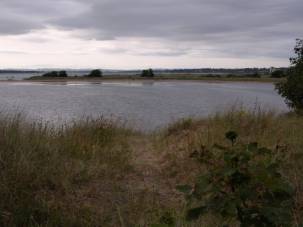
This shallow bay on the estuary side of the spit
was
one of the last places on the Exe to be covered by high tide but changes in the
estuary mean this is now Cockle Sands off Exmouth. Despite this,
it is one of the first and last places waders feed either side of the
tide, were they can be checked and counted relatively easily. Dunlin and Ringed
Plover use the area most on the falling tide, the larger waders preferring to
wait to feed on the wider estuary. There is
often a build up of larger gulls also either side of the tide with up to 500 Greater
Black-backed Gull being counted, although numbers are now much reduced. At high tide it also provides a feeding area
for Brent Geese and Shelduck, although diving duck, such as mergansers, prefer
the deeper water of the main estuary. Rarities recorded using the Bight,
include Semipalmated and Greater Sand Plover, although most of the rare waders
recorded on site have also used the area. Other species include Caspian and Iceland Gull, Shorelark and Leach’s Petrel.
Being a tidal area few
plants occur but those that do are regionally important, due to the scarcity of
this habitat in the southwest. Several
species of Glasswort have been recorded along with other species such as Annual Seablite and Sea Purslane. At present it seems the bay is slowing silting up
with areas of saltmarsh increasing.
|
Since the early 1990’s
this promontory on the western corner of Warren Point has developed into an
important roosting area. Prior to this the area would be
covered by high tides but coastal processes have built up the spit, the
addition of fencing to protect the area over high tide has also reduced
disturbance to roosting birds. As the
point has built up, several strandline and embryo dune plant species have
colonised, these include Frosted Orache and Sand Couch. The area can become the
main roost depending on weather and disturbance, Curlew often use the point
on an evening tide or if the Railway Saltmarsh is disturbed. A few waders
have been recorded here over a high tide before disappearing, these include
Kentish Plover, Purple, and most recently, Pectoral Sandpiper. The first record of Lesser Yellowlegs spent time on the northern shore of
Finger Point, where it was not visible from the hide. |
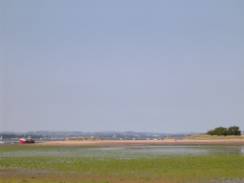 |
The Hide and Roost
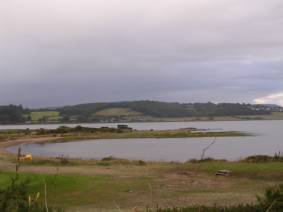
The hide is situated on a small promontory of land
belonging to the Wildlife Trust overlooking an area that is a popular roost site. It gives great views across the Bight and onto Finger Point as well
as across the estuary to the Railway Saltmarsh. The same coastal processes that
have built up Finger Point and areas of the Bight reduced the potential of
this area as a high tide roost, so an artificial island has been constructed. This
too is constantly altered by the power of the tides, but remains a key roost
for species such as Oystercatcher. The wooden posts also provide roosting sites
for terns, allowing many colour rings to be read.
These flocks, mainly Sandwich Tern, often hold Roseate Tern in midsummer, the Warren is an important site for this species, rarities have included Gull-billed, Caspian, Elegant and Lesser Crested Tern.
The bramble scrub behind the hide usually holds breeding Whitethroat and Linnet, whilst Great Tit often use a hole in the hide itself. The saltmarsh around the hide hosts a population of the rare cranefly Geronomyza bezzii at possibly its last UK site.
Railway Saltmarsh,
Shutterton Creek and Wreck
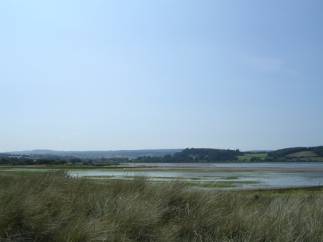
This area along with the Golf Course is not open
to the public and because of this lack of disturbance is an important
roosting and feeding site. Curlew and Godwits, along with smaller numbers of
other waders, roost on the Railway Saltmarsh before moving onto the mudflats
with the receding tide. Large numbers of Black-headed Gulls roost here over
high tide and in the evening, with Mediterranean Gull often being picked out.
In the summer the tern flock can also gather here at low tide. Grey Heron and Little Egret
also roost in this area, these have been joined by rarer species such as
Spoonbill, Cattle and Great White Egret.
In autumn and winter large flocks of Brent Geese, Teal and Wigeon can be seen, other wildfowl can be scarce on site but are most often picked up with these birds. In winter over the high tide, Red-breasted Merganser, Goldeneye and sometimes Long-tailed Duck can be seen feeding in Shutterton Creek and around the Wreck. Cormorant and Shag use the Wreck as a roost at high tide and Kingfisher can sometimes be seen.
The saltmarsh vegetation is
similar to that found around the Hide and Bight but is slowly being eroded by
rising sea levels and Cordgrass is only present in many areas. This may soon
also disappear; hopefully the displaced birds will be able to adjust to other
roosting areas within the SPA, certainly the habitat creation at the north end
of the estuary has reduced numbers travelling from feeding areas to the Warren
on each tide.
This area can be difficult
to view and a telescope is essential, on sunny days the heat haze and sunset can cause severe problems. The tern flocks are often flushed by passing
trains at high tide, this is the best time to try and pick up any Roseates, before they
settle down again amongst the saltmarsh vegetation. Trains rarely flush the
waders, except Common Sandpiper; in July they can often be picked out flying
along the estuary wall as a train passes.
|
This area, along with the
mudflats and saltmarsh, is owned by the Devon Wildlife Trust and is not
open to the public at any time. The lack of disturbance allows many species
to thrive, many waders and wildfowl feed along the saltmarsh edge and co-exist
happily alongside golfers. In winter Brent Geese, and in spring Whimbrel,
can regularly be seen feeding on the fairways between groups of players. The
fairways are also favoured areas for Wheatear, whilst the Gorse supports good
populations of Linnet and Whitethroat. The careful management of the fairways allows for several dune plant species to survive, Sand Crocus is the most well known of these, but many rare or scarce grasses, clovers and storksbills also occur. Other interesting plants found elsewhere on the course include Brackish Water-crowfoot, but Allseed, Royal Fern and Grass Vetchling all appear to have been lost. |
 |